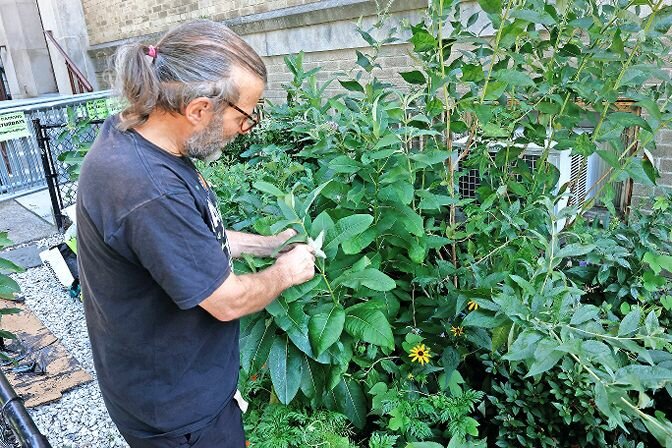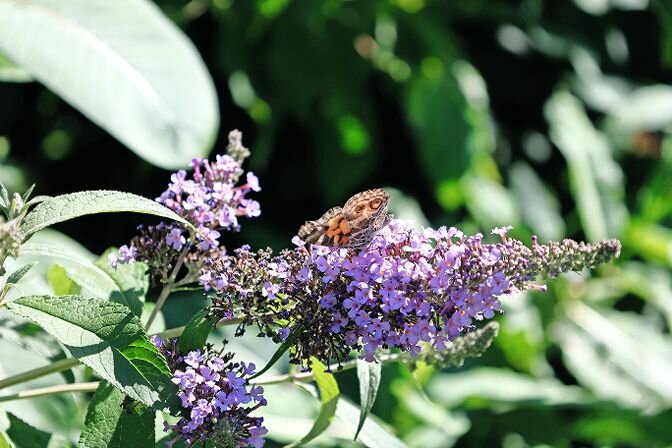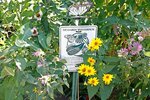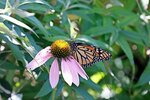Inwood Butterfly Sanctuary: Urban oasis protects monarchs and inspires conservation
Keith De Cesare, summarizing the garden nestled along the corner of the former Inwood religious sanctuary, Church of the Good Shepherd, called it “a sanctuary within a sanctuary.”
There’s a reason for that.
The new sanctuary, dedicated not to nuns but bugs, is a project founded in 2019 by De Cesare and his wife, Adriana, with the help of many volunteers. Five years later, it has developed into a beloved community green space, proving more vital than ever as the eastern monarch butterfly population faces unprecedented decline.
In the 300-square-foot garden, where there were once several hundred monarchs, there are now only several dozen.
This crisis is primarily due to human activities like pesticide use, climate change and overdevelopment, all of which devastate the monarch’s breeding grounds and sole food source during the larval stage: milkweed.
In response, butterfly gardeners on Governors Island have declared 2024 “The Year of Milkweed,” encouraging New Yorkers to grow this essential flora in backyard gardens, windowsills or wherever a small plant could flourish.
The Inwood Butterfly Sanctuary shares this vision, with lead gardener De Cesare offering pre-potted milkweed sprouts ready for visitors to take home. On his own, he sometimes partakes in what is considered a form of guerrilla gardening — finding any suitable place milkweed might grow and letting the seeds take flight.
Designed specifically to boost monarch numbers, the sanctuary employs an innovative habitat management system. By placing fine mesh bags over caterpillars to shield them from predators like parasitic flies and wasps, De Cesare can fully invert the young butterflies’ rate of survival from 2 percent in the wild to 98 percent.
Monarchs are unique among butterflies for their annual migration from Mexico to Canada and back — a 4,000-mile round trip. New York City lies along the Eastern Flyway, a crucial monarch and bird migrational route along the Hudson River. Without sufficient habitat along this route, there is a risk of migratory collapse. Monarchs are also an indicator species, meaning their decline reflects larger ecological imbalances.
De Cesare said the Inwood/Riverdale region, with its lawn-dominated monoculture, lacks the native plant diversity monarchs thrive upon. In contrast, the sanctuary teems with both milkweed and pollinator flowers like echinacea and sunflowers that tower far above passerby, adding a sense of storybook wonder to a busy street corner.
This magic holds a special allure for children, including the De Cesares’ three, who regularly participate in garden activities along with friends and classmates. The sanctuary doubles as an educational hub, with initiatives such as school enclosures and caterpillar adoption kits, which allow kids to observe the butterfly life cycle firsthand. Exhibits at the recent “Pollinator Palooza” in Riverdale and the upcoming New York City Flower and Garden Show complement their outreach efforts.
To De Cesare, this advocacy helps foster the idea “that kids will grow up and take these experiences with them into adult life as conservationists or stewards of the environment.”
While other waystations exist around the city, notably in Central Park and on Governors Island, De Cesare envisions a larger network of sanctuaries through city grants or park partnerships. This opportunity may come in September if the monarch gains threatened status under the Endangered Specis Act, potentially unlocking federal protection.
In the meantime, community efforts remain the most potent force for change. The Inwood sanctuary envisions further expansion but, on a shoestring budget, relies on community volunteering and donations. An active GoFundMe campaign, supported by groups like Riverdale’s Art for Aid, aims to fund additional habitat restoration nets and a walk-in observation enclosure for future visitors to interact more closely with butterflies.
“The garden is just a small part of our mission,” De Cesare said. The broader mission, through the monarch’s struggle, is to connect communities with “a larger battle for biodiversity and environmental health.”














